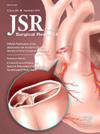吞咽困难的中风患者的胃造口术技术比较:熵平衡分析。
IF 1.8
3区 医学
Q2 SURGERY
引用次数: 0
摘要
导言:肠内营养通常通过经皮内镜胃造口术(PEG)或放射学插入胃造口术(RIG)技术进行。本研究比较了 PEG 和 RIG 对因脑梗塞导致吞咽困难的成人患者的围手术期疗效:回顾性研究了 2018 年至 2020 年期间在一家三级医疗中心接受 PEG 或 RIG 治疗的成人脑卒中患者。使用熵平衡权重调整了 PEG 和 RIG 患者的基线特征差异。结果:217 名卒中患者符合纳入标准,其中 37 人(17.0%)接受了 PEG,180 人(83.0%)接受了 RIG。与 PEG 相比,接受 RIG 的患者更多是医疗保险受益人,而且根据 Charlson 合并症指数衡量,合并症负担更重。PEG 和 RIG 达到进食目标的时间相当(分别为 3 d [四分位间范围 2-5] vs 4 d [四分位间范围 3-5],P = 0.059)。经多变量调整后,RIG 与较低的再次手术几率(调整几率比 [AOR] 0.10,95% CI 0.02-0.50,P = 0.005)、脑血管意外(AOR 0.24,95% CI 0.00-0.74,P = 0.030)和入住重症监护室(AOR 0.14,95% CI 0.03-0.70,P = 0.017)显著相关。RIG患者院内死亡的风险因素包括心律失常(AOR 6.54,95% CI 1.67-15.48,P = 0.009)、心肌梗死(AOR 4.78,95% CI 2.25-10.23,P = 0.009)和肥胖(AOR 4.48,95% CI 1.03-9.61,P = 0.047):虽然两种技术都是中风患者肠内喂养的有效方法,但 RIG 可降低围手术期的发病率。当地的转诊模式和患者的个体合并症可能会影响 PEG 或 RIG 的治疗效果,因此必须谨慎选择患者。本文章由计算机程序翻译,如有差异,请以英文原文为准。
Comparison of Gastrostomy Techniques in Stroke Patients With Dysphagia: An Entropy-Balanced Analysis
Introduction
Enteral nutrition is commonly placed via percutaneous endoscopic gastrostomy (PEG) or radiologically inserted gastrostomy (RIG) techniques. This study compared perioperative outcomes of PEG and RIG in adults with dysphagia caused by cerebral infarction.
Methods
Adult stroke patients who underwent either PEG or RIG between 2018 and 2020 at a tertiary care center were reviewed retrospectively. Differences in baseline characteristics between PEG and RIG patients were adjusted using entropy-balanced weights. Multivariable weighted logistic and linear regressions were subsequently developed to evaluate the independent association between RIG and outcomes of interest.
Results
217 stroke patients met inclusion criteria, of whom 37 (17.0%) received PEG and 180 (83.0%) received RIG. Compared to PEG, patients with RIG were more commonly Medicare beneficiaries and had a higher burden of comorbidities as measured by the Charlson comorbidity index. Time to achieve goal feeds was comparable between PEG and RIG (3 d [interquartile range 2-5] vs 4 d [interquartile range 3-5], respectively, P = 0.059). After multivariate adjustment, RIG was associated with significantly lower odds of reoperation (adjusted odds ratio [AOR] 0.10, 95% CI 0.02-0.50, P = 0.005), cerebrovascular accident (AOR 0.24, 95% CI 0.00-0.74, P = 0.030), and intensive care unit admission (AOR 0.14, 95% CI 0.03-0.70, P = 0.017). Risk factors for in-hospital mortality among RIG included arrhythmia (AOR 6.54, 95% CI 1.67-15.48, P = 0.009), myocardial infarction (AOR 4.78, 95% CI 2.25-10.23, P = 0.009), and obesity (AOR 4.48, 95% CI 1.03-9.61, P = 0.047).
Conclusions
While both techniques are effective methods of enteral feeding in stroke patients, RIG may confer lower perioperative morbidity. Local referral patterns and individual patient comorbidities could influence outcomes following PEG or RIG, necessitating careful patient selection.
求助全文
通过发布文献求助,成功后即可免费获取论文全文。
去求助
来源期刊
CiteScore
3.90
自引率
4.50%
发文量
627
审稿时长
138 days
期刊介绍:
The Journal of Surgical Research: Clinical and Laboratory Investigation publishes original articles concerned with clinical and laboratory investigations relevant to surgical practice and teaching. The journal emphasizes reports of clinical investigations or fundamental research bearing directly on surgical management that will be of general interest to a broad range of surgeons and surgical researchers. The articles presented need not have been the products of surgeons or of surgical laboratories.
The Journal of Surgical Research also features review articles and special articles relating to educational, research, or social issues of interest to the academic surgical community.

 求助内容:
求助内容: 应助结果提醒方式:
应助结果提醒方式:


